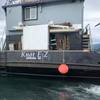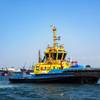U.S. Ships Bring Water to Tsunami-Stricken Islands
Lummus and Bonnyman belong to Maritime Prepositioning Ship Squadron 3, a group of 11 ships deployed to the Guam/Saipan area laden with enough cargo to sustain a Marine Expeditionary Brigade for 30 days. Together, the ships delivered more than 100,000 gallons of water, $3,000 of medical supplies and more than 20 tons of food.
The Maldives is a string of more than 1,000 islands located 2,000 nautical miles east from the Dec. 26 earthquake's epicenter. Nearly 13,000 of the country's 330,000 residents were displaced by the tsunami's powerful waves.
Lummus and Bonnyman moored offshore from several islands in the Laamu Atoll, approximately 200 miles south of the capitol atoll of Male in the Maldives. Water was made using a reverse osmosis water purification system, a piece of equipment Marine expeditionary brigades use to make potable water from seawater. Portable water pumps, water pods and other storage devices were used to make and keep water for the local villagers. The water was transported from island to island by Marine Corps amphibious craft.
"It feels good to be able to help out and use the assets of these ships to their capacity," said Capt. Conrad B. Divis, commander of MPSRON 3. "The local villages really appreciate the assistance we provided."
Each new island provided a new technical challenge for the tsunami relief. Beach access or availability, empty storage space and the ability of the villagers to help the distribution of the supplies varied greatly from island to island.
"Thanks to the ingenuity of our junior Sailors and Marines, we were able to devise several different means of water delivery and distribution to adapt to the unique challenges of each island," said Capt. James J. Bird, commander of Naval Beach Group 1, a group responsible for planning and executing amphibious landing force operations for Navy ships.
"The Sailors, Marines and mariners on board were able to do things that they had never done before. Each and every person was key to the success of this mission."
More than a dozen of MSC's 140 ships have been involved in Operation Unified Assistance. MSC ships replenish Navy ships at sea, chart ocean bottoms, conduct undersea surveillance, preposition combat cargo at sea, and move 95 percent of military equipment and supplies used by deployed U.S. forces.












